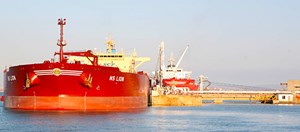Russia oil flow jumps to 4 million barrels a day as Asia buys
(Bloomberg) — Asia is still snapping up cheap Russian oil that European buyers don’t want.
Seaborne exports of the nation’s crude rebounded in the seven days to April 22. One-fifth of the volume shipped from ports on the Black Sea, Baltic and Arctic coasts is on tankers showing no final destination, with most expected to end up in Asia.
A total of 40 tankers loaded about 28 million barrels from Russian export terminals, according to vessel-tracking data and port agent reports collated by Bloomberg. That put average seaborne crude flows at 4 million barrels a day, up by 25% against the week ended April 15. The weather played a big part.
The jump in oil exports means a boost to revenues for Moscow as President Vladimir Putin steps up his war in Ukraine, while the U.S. and EU discuss options to wean Europe off Russian oil. At current rates of crude oil export duty, the week’s shipments will have earned the Kremlin about $232 million; that’s $46 million more than the previous week.
Russia exports crude from four main areas: the Baltic Sea in northwest Europe, the Black Sea, the Arctic, and terminals on its Pacific Coast. From three of the four areas, flows to Asia or unknown destinations rose.
The weekly shipment figures can swing depending on the timing of when tankers depart, which is also heavily influenced by the weather at ports -- as has been the case for the past several weeks.
The past week saw higher aggregate volumes from all four regions. Flows of Urals and Siberian Light crude from terminals in the Baltic and Black Sea rose by 663,000 barrels a day, or 36%. The volume of crude leaving the Black Sea port of Novorossiysk more than doubled as a backlog of ships that built up during the previous week’s bad weather started to clear.
Meanwhile, shipments from the country’s three eastern terminals on its Pacific Ocean coast were up by 105,000 barrels a day, or 10%. Cargoes from Murmansk, which handles crude produced along Russia’s Arctic coastline were also up, increasing by 29,000 barrels a day, or 9%.
This month, Russia’s seaborne crude shipments up to April 22 averaged 3.2 million barrels a day. In full year 2021, they averaged 2.88 million a day.
U.S. officials and the European Union are in talks over steps the EU could take to restrict oil imports from Russia and cut Moscow’s income from sales. Options include an import ban, a price cap and a payment mechanism to withhold revenue. Russia’s production in the first two weeks of April was down by about 800,000 barrels a day from March.
There has been little impact on Moscow’s earnings from crude exports so far. The rebound in crude flows from Russia’s export terminals in the eighth week after the invasion boosted the Kremlin’s export duty revenues by 25% week-on-week.
Crude oil export duty is set at $61.20 a ton in April, equivalent to about $8.30 a barrel. That’s up from $58.30 a ton, $7.95 a barrel, in March and is calculated from an average Urals price over the period from Feb. 15 to March 14. Export duty will fall to $49.60 a ton, $6.81 a barrel, in May.
A gale warning for the Novorossiysk area issued on April 12 halted flows from the terminal for the latter part of that week, with no tankers mooring at the crude oil jetty between April 12 and April 15. The backlog of tankers that built up was slowly being reduced last week, but loadings were still running about six days behind schedule by the end of the week.



